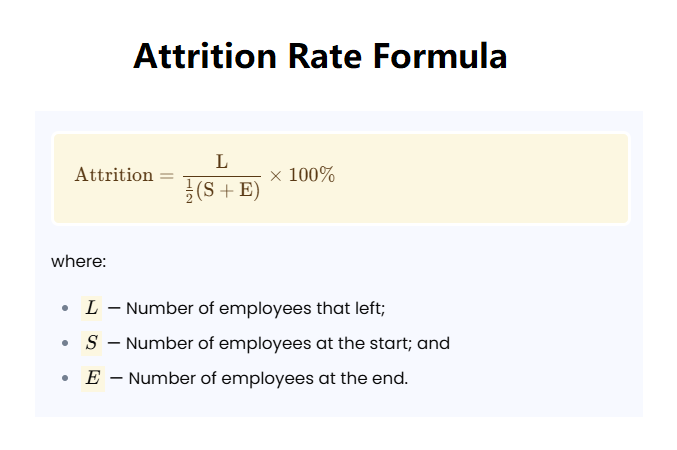 Home
Home
 Back
Back

Definition: This calculator computes the attrition rate, which is the percentage of employees who leave a company over a specified period, either voluntarily or involuntarily. It is a key metric for assessing workforce stability.
Purpose: It is used by HR departments to monitor employee turnover, evaluate employee satisfaction, and identify potential issues in the workplace that may lead to high attrition rates.
The calculator uses the attrition rate formula:
\( \text{Attrition Rate} (\%) = \left( \frac{\text{Number of Employees Who Left}}{\text{Average Number of Employees}} \right) \times 100 \)
Where the average number of employees is:
\( \text{Average Number of Employees} = \frac{\text{Employees at Start} + \text{Employees at End}}{2} \)
Steps:
Calculating the attrition rate is essential for:
Example 1: Calculate the attrition rate for a company that started with 100 employees, ended with 90 employees, and had 15 employees leave during the period:
Example 2: Calculate the attrition rate for a company that started with 50 employees, ended with 60 employees, and had 5 employees leave during the period:
Q: What is an attrition rate?
A: The attrition rate is the percentage of employees who leave a company over a specified period, reflecting turnover due to voluntary or involuntary reasons like resignation, retirement, or termination.
Q: What is considered a good attrition rate?
A: A good attrition rate varies by industry, but generally, rates below 10% are considered healthy, indicating strong employee retention. High rates (e.g., above 20%) may signal underlying workplace issues.
Q: How can companies reduce attrition rates?
A: Companies can reduce attrition by improving workplace culture, offering competitive compensation, providing growth opportunities, and ensuring work-life balance through policies like flexible hours or paid leave.